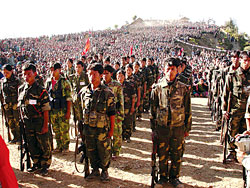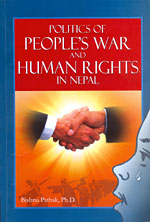 Bad news is always not bad especially when it comes to publishing opportunities. Nepal has never been so well-known worldwide as today, when writing about the conflict has far overshadowed the books about sex workers and mountain adventures that used to dominate bookstores' 'Nepal' sections.
Bad news is always not bad especially when it comes to publishing opportunities. Nepal has never been so well-known worldwide as today, when writing about the conflict has far overshadowed the books about sex workers and mountain adventures that used to dominate bookstores' 'Nepal' sections.
Dozens of volumes have already been written about the Nepali Maoists, their leaders, history and ideologies but another new book on this issue is always an attraction. Dutch University scholar Bishnu Pathak had only planned to write the dissertation for his PhD but after researching and collating information for nearly seven years, he turned his work into a book. The result is one of the most comprehensive and exhaustively researched publications on the politics of the Maoist insurgency, with a heavy dose of discussion on human rights.
What makes this book, Politics of People's War and Human Rights in Nepal, stand out is the author's inclusion of academic theories on the Maoist uprising and a presentation of western vs eastern perspectives on human rights. It comes at an opportune time as Maoist leaders are now transforming themselves from pure communist ideologists to politicians, as evident in their flexibility to accept political solutions ranging from one-party government to a multiparty system and in the willingness of Maoist leaders Baburam Bhattarai and Prachanda to work closely with the same political parties they once vowed to eliminate.
With its 472 pages, the book is a useful blow-by-blow account of the Maoists since before the 'people's war' period. More interesting is its detailed study of how human rights concepts evolved from the 6th century Lichchabi period to today. Human rights is no longer limited to social reforms such as Rana leaders abolishing sati but has more direct links with democracy, argues Pathak, an assistant professor at TU where he is also establishing a department on conflict studies.
The author argues that what works in western liberal society might not succeed in eastern countries because of cultural and ideological differences. But the bottom line about human rights is that freedom from torture, detention, exploitation and the right to democracy and free speech are universal.
Pathak's conclusion is that the 'people's war' has ended up abusing the people it was meant to help. The state has been no better. While the Maoists made deliberate killings, abductions and extortion of food grains and money part of their modus operandi, the state answered with more extra-judicial killings, disappearances, arbitrary arrests and torture. He also rebukes the international community for ignoring growing human rights abuses in Nepal. Only after 10 years and 12,000 lives lost and thousands more disappeared has the UN finally been allowed to get involved by the powers that be.
Pathak does jump to the wrong conclusion when he states that many people have started dying of hunger since the conflict began. Food deficit has always been a problem in certain parts of the country: the Maoists have not really made the situation worse. The poorest families have become the most productive farmers after the huge land holdings of exploitative landlords were redistributed among them. Other land has been seized by the rebels but farming continues no matter who owns it, with migrant Nepalis still returning from India to their villages for planting and harvesting. Land reform initiated by the Maoists has succeeded whereas those of previous governments failed.
The author concludes that there is no alternative but for the government, parties and Maoists to patch things and for all to agree to the latter's demand for a constituent assembly, which is both a rights-based and the most democratic solution. Peace talks, he concludes, will never succeed as long as arms merchants traffickers and feudal elements, particularly the royal family and its supporters, profit from the conflict.
 Politics of People's War and Human Rights in Nepal
Politics of People's War and Human Rights in Nepal
BIMIPA Publications, Kathmandu, 2005
472 pages
ISBN: 99933-939-0-8


